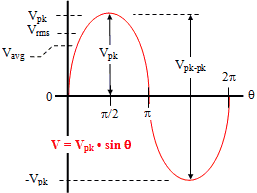|
A sinewave is defined by the trigonometric sine function. When plotted as voltage (V) as a function of phase (θ),
it looks similar to the figure to the right. The waveform repeats every 2p
radians (360°), and is symmetrical about the voltage axis (when no DC offset is present). Voltage and current exhibiting
cyclic behavior is referred to as alternating; i.e., alternating current (AC). One full cycle is shown here. The basic
equation for a sinewave is as follows:

There are a number of ways in which the amplitude of a sinewave is referenced, usually as peak voltage (Vpk
or Vp), peak-to-peak voltage (Vpp or Vp-p or Vpkpk or Vpk-pk),
average voltage (Vav or Vavg), and root-mean-square voltage (Vrms). Peak voltage
and peak-to-peak voltage are apparent by looking at the above plot. Root-mean-square and average voltage are not so
apparent.
Also see Triangle Wave Voltages and
Square Wave Voltages pages.
Root-Mean-Square Voltage (Vrms)
 As
the name implies, Vrms is calculated by taking the square root of the mean average of the square of the
voltage in an appropriately chosen interval. In the case of symmetrical waveforms like the sinewave, a quarter cycle
faithfully represents all four quarter cycles of the waveform. Therefore, it is acceptable to choose the first quarter
cycle, which goes from 0 radians (0°) through p/2 radians
(90°). As
the name implies, Vrms is calculated by taking the square root of the mean average of the square of the
voltage in an appropriately chosen interval. In the case of symmetrical waveforms like the sinewave, a quarter cycle
faithfully represents all four quarter cycles of the waveform. Therefore, it is acceptable to choose the first quarter
cycle, which goes from 0 radians (0°) through p/2 radians
(90°).
Vrms is the value indicated by the vast majority of AC voltmeters. It is the value that, when applied
across a resistance, produces that same amount of heat that a direct current (DC) voltage of the same magnitude would
produce. For example, 1 V applied across a 1 Ω resistor produces 1 W of heat. A 1 Vrms sinewave applied
across a 1 Ω resistor also produces 1 W of heat. That 1 Vrms sinewave has a peak voltage of √2 V (≈1.414
V), and a peak-to-peak voltage of 2√2 V (≈2.828 V).
Since finding a full derivation of the formulas for root-mean-square (Vrms) voltage is difficult, it
is done here for you.


So,
 ≈ 0.707 Vpk, where
≈ 0.707 Vpk, where
 = 0.70710678118654752440084436210485
= 0.70710678118654752440084436210485
Average Voltage (Vavg)
As the name implies, Vavg is calculated by taking the average of the voltage in an appropriately chosen
interval. In the case of symmetrical waveforms like the sinewave, a quarter cycle faithfully represents all four quarter
cycles of the waveform. Therefore, it is acceptable to choose the first quarter cycle, which goes from 0 radians (0°)
through p/2 radians (90°).
As with the Vrms formula, a full derivation for the Vavg formula is given here as well.

So,  ≈ 0.636 Vpk, where
≈ 0.636 Vpk, where
 = 0.63661977236758134307553505349006
= 0.63661977236758134307553505349006
* I have no idea why we write "Sinewave," but not "Trianglewave" and "Squarewave."
|








 As
the name implies, Vrms is calculated by taking the square root of the mean average of the square of the
voltage in an appropriately chosen interval. In the case of symmetrical waveforms like the sinewave, a quarter cycle
faithfully represents all four quarter cycles of the waveform. Therefore, it is acceptable to choose the first quarter
cycle, which goes from 0 radians (0°) through
As
the name implies, Vrms is calculated by taking the square root of the mean average of the square of the
voltage in an appropriately chosen interval. In the case of symmetrical waveforms like the sinewave, a quarter cycle
faithfully represents all four quarter cycles of the waveform. Therefore, it is acceptable to choose the first quarter
cycle, which goes from 0 radians (0°) through 

 ≈ 0.707 Vpk,
≈ 0.707 Vpk, = 0.70710678118654752440084436210485
= 0.70710678118654752440084436210485

 ≈ 0.636 Vpk,
≈ 0.636 Vpk, = 0.63661977236758134307553505349006
= 0.63661977236758134307553505349006
